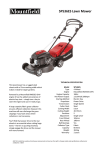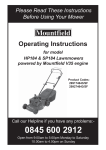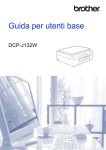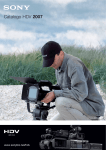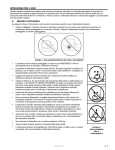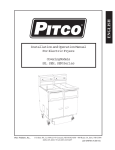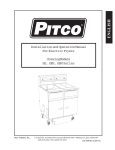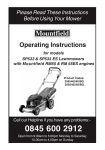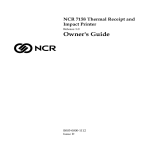Download Mountfield Multiclip 501SP Specifications
Transcript
Multiclip 501SP Lawn Mower TECHNICAL SPECIFICATION Do you collect your grass clippings? Do they end up in a rotting heap tucked away in a corner of your garden? There is an M Multiclip cutting technology. Gone are the days when recycling your clippings meant sacrificing the standard of finish and you will save time, money and effort. This mower is powered by a Mountfield RM45 OHV engine and has a 48cm cutting width. Front wheel drive and handles which can be offset to either side make it easy to cut your grass even when you are working alongside hedges or other barriers. Look no further if you want a life free of grass clippings. Model Type Engine Engine Capacity Net Power Output Starting Method Propulsion Transmission Cutter Deck Cutting Width Cutting Height Positions Adjustment Front Wheel Rear Wheel Ball Bearings Collector Type Capacity Weight Warranty Multiclip 501SP 4 Wheel Mulching Mountfield RM45 OHV 140cc 2.22kW @2900rpm Recoil Power Drive Single Speed Steel 48cm 31-75mm 5 3 Levers 210mm 210mm Yes - Double n/a n/a 34.0kg 2 years GGP UK Limited has a policy of continuous improvement and reserves the right to change models and specifications without prior notification. E&OE Please Read These Instructions Before Using Your Mower Operating Instructions for model Multiclip 501SP Lawnmower with Mountfield RM45 engine Product Code: 291502148/BQ Call our Helpline if you have any problems:- 0845 600 2912 Open from 9:00am to 5:00pm Monday to Saturday 10.00am to 4.00pm on Sunday IT ITALIANO - Istruzioni Originali - Norme di sicurezza......................................................................................4-7 - Funzionamento............................................................................................8-11 - Risoluzione problemi...................................................................................11 EN ENGLISH - Translation of the original instructions (Istruzioni Originali) - Safety precautions.......................................................................................12-15 - How to get mowing.......................................................................................16-19 - Fault Finding................................................................................................19 GUARANTEE................................................................................................ 20 3 Geazie per aver acquistato un rasaerba Mountfield. Questa macchina garantirà molti annI di affidabile e sicuro lavoro se utilizzata secondo le seguenti istruzioni. Preghiamo di leggere e capire attentamente le istruzioni di utilizzo prima di usare il rasaerba, eventuali omissioni potrebbero causare danni a persone o alla macchina. NON INCLINARE IL RASAERBA SUL SUO FIANCO, LA FUORIUSCITA DI OLIO POTREBBE DANNEGGIARE IL FILTRO ARIA. é il manico si appoggia a terra. NORME DI SICUREZZA Il Vostro rasaerba deve essere utilizzato con prudenza. A tale scopo, sulla macchina sono stati posti dei pittogrammi, destinati a ricordarvi le principali precauzioni d’uso. Il loro significato è spiegato qui di seguito. Vi raccomandiamo inoltre di leggere attentamente le norme di sicurezza riportate nell’apposito capitolo del presente libretto. 1. Attenzione: Leggere il libretto istruzioni prima di usare la macchina. 2. Rischio di espulsione: tenere le persone al di fuori dell’area di lavoro, durante l’uso. 3. Attenzione: scollegare il cappuccio della candela prima di effettuare qualsiasi operazione di manutenzione o riparazione. 4.Rischio di tagli: Lame in movimento.Non introdurre mani o piedi all’interno dell’alloggiamento lama. 5 5. Attenzione alle superfici calde DESCRIZIONE DEI SIMBOLI RIPORTATI SUI COMANDI 8 9 10 11 12. 12 13 8. Lento 9. Veloce 10. Starter 11. Arresto avanzamento 12. Trazione inserita 13. Arresto motore Valori massimi di rumorosità e vibrazioni Livello di pressione acustica orecchio operatore (in base alla norma 81/1051/EEC)........................................ db(A) 80,0 - Incertezza di misura (2006/42/EC / EN 27574).......................db(A) 1,2 ____________________________________________________________ Livello di potenza acustica misurato (in base alla direttiva 2000/14/EC, 2005/88/EC)........................ db(A) 93,0 - Incertezza di misura (2006/42/EC / EN 27574)........................ db(A) 1,0 ____________________________________________________________ Livello di potenza acustica garantito (in base alla direttiva 2000/14/EC, 2005/88/EC)........................ db(A) 94 ____________________________________________________________ Livello di vibrazioni (in base alla direttiva EN 1033)................... m/s2 9 - Incertezza di misura (2006/42/EC / EN 12096)...........................m/s2 1,2 4 ETICHETTA DI IDENTIFICAZIONE L WA kg dB 1. Livello di potenza acustica secondo la direttiva 2000/14/EC. 2. Marchio di conformità secondo la direttiva 98/37/EEC (2006/42/EC dal 29/12/2009). 3. Tipo di rasaerba 4. Modello di rasaerba 5. Numero di matricola. 6. Nome e indirizzo del costruttore. 7. Codice articolo. 8. Anno di fabbricazione. Immediatamente dopo l’acquisto della macchina, trascrivere i numeri di identificatione (3-5-6) negli appositi spazi sull’ultima pagina del manuale. CONOSCERE LA MACCHINA Leva presenza operatore / freno motore (OPC) Leva innesto trazione Fune e guida fune Acceleratore Tappo riempimenti olio/ Astina di livello (posizione: sul retro del motore) Motore Manico Manopola di fissaggio Marmitta Regolazione altezza di taglio Tappo serbatoio carburante (posizione: sul retro del motore) Candela Piatto di taglio Fltro dell’aria 5 Le seguenti norme di sicurezza devono essere osservate ad ogni utilizzo. Preghiamo di leggerle attentamente. ADDESTRAMENTO 1) Leggere attentamente le istruzioni. Prendere famigliarità con i comandi e con un uso appropriato del rasaerba. imparare ad arrestare rapidamente il motore. 2) Utilizzate il rasaerba per lo scopo al quale è destinato, cioè per il taglio dell’erba. Qualsiasi altro impiego può rivelarsi pericoloso e causare il danneggiamento della macchina. Rientrano nell’uso improprio (come esempio, ma non solo): –trasportare sulla macchina persone, bambini o animali; –farsi trasportare dalla macchina; –usare la macchina per trainare o spingere carichi; –usare la macchina per la raccolta di foglie o detriti; –usare la macchina per regolarizzare siepi, o per il taglio di vegetazione di tipo non erboso; –utilizzare la macchina in più di una persona; –azionare la lama nei tratti non erbosi. 3) Non permettere mai che il rasaerba venga utilizzato da bambini o da persone che non abbiano la necessaria dimestichezza conle istruzioni. Le leggi locali possono fissare un’età minima per l’utilizzatore. 4) Non utilizzare mai il rasaerba: –con persone, in particolare bambini, o animali nelle vicinanze. –se l’utilizzatore ha assunto farmaci o sostanze ritenute nocivealle sue capacità di riflessi e attenzione. 5) Ricordare che l’operatore o l’utilizzatore è responsabile di incidenti e imprevisti che si possono verificare ad altre persone o alleloro proprietà. 6) Mai introdurre mani o piedi all’interno dell’alloggiamento lame. La lama continua a ruotare per un po’ di tempo anche dopo lo spegnimento della macchina. OPERAZIONI PRELIMINARI 1) Durante il taglio, indossare sempre calzature solide e pantaloni lunghi. Non azionare il rasaerba a piedi scalzi o consandali aperti. 2) Ispezionare a fondo tutta l’area di lavoro e togliere tutto ciò che potrebbe venire espulso dalla macchina o danneggiare il gruppodi taglio e il motore (sassi, rami, fili di ferro, ossi, ecc.). 3) ATTENZIONE: PERICOLO! La benzina è altamente infiammabile: –conservare il carburante in appositi contenitori. –rabboccare il carburante, utilizzando un imbuto, solo all’aperto e non fumare durante questa l’operazione e ognivolta che si maneggia il carburante. –rabboccare prima di avviare il motore; non aggiungere benzinao togliere il tappo del serbatoio quando il motore è in funzioneo è caldo; –se fuoriesce della benzina, non avviare il motore, ma allontanare il rasaerba dall’area nella quale il carburante è stato versato, edevitare di creare possibilità di incendio, fintanto che il carburantenon sia evaporato ed i vapori di benzina non si siano dissolti. –rimettere sempre e serrare bene i tappi del serbatoio e del contenitore della benzina. 4) Sostituire i silenziatori difettosi. Mai utilizzare la macchina senza silenziatore. 5) Prima dell’uso, procedere ad una verifica generale ed inparticolare dell’aspetto delle lame, e controllare che le viti e il gruppo di taglio non siano usurati o danneggiati. Sostituire inblocco le lame e le viti danneggiate o usurate per mantenere l’equilibratura. UTILIZZO 1) 2) 3) 4) 5) 6) 7) 8) 9) 6 Non azionare il motore in spazi chiusi, dove possono accumularsi pericolosi fumi di monossido di carbonio. Lavorare solamente alla luce del giorno o con buona luce arti-ficiale. Se possibile, evitare di lavorare nell’erba bagnata. Accertarsi sempre del proprio punto d’appoggio sui terreni inpendenza. Non correre mai, ma camminare; evitare di farsi tirare dalrasaerba. Tagliare nel senso trasversale al pendio e mai su e giù. Prestare la massima attenzione nel cambio di direzione sui pendii. Non tagliare su terreni con pendenza superiore a 20°. Prestare estrema attenzione quando tirate il rasaerba verso di voi. 10) Fermare la lama se il rasaerba deve essere inclinato per il trasporto, nell’attraversare superfici non erbose, e quando il rasaerba viene trasportato da o verso l’area che deve essere tagliata. 11) Non azionare mai il rasaerba se i ripari sono danneggiati 12) Non modificare le regolazioni del motore, e non fare raggiungere al motore un regime di giri eccessivo. 13) Nei modelli con trazione, disinnestare l’innesto della trasmissione alle ruote, prima di avviare il motore. 14) Avviare il motore con cautela secondo le istruzioni e tenendoi piedi ben distanti dalla lama. 15) Non inclinare il rasaerba per l’avviamento. Effettuare l’avviamento su una superficie piana e priva di ostacoli o erba alta. 16) Non avvicinare mani e piedi accanto o sotto le parti rotanti. State sempre lontani dall’apertura di scarico. 17) Non sollevare o trasportare il rasaerba quando il motore è infunzione. 18) Fermare il motore e staccare il cavo della candela: –prima di qualsiasi intervento sotto il piatto di taglio o prima di disintasare il convogliatore di scarico; –prima di controllare, pulire o lavorare sul rasaerba; –dopo aver colpito un corpo estraneo. Verificare eventuali dannisul rasaerba ed effettuare le necessarie riparazioni prima diusare nuovamente la macchina; –se il rasaerba comincia a vibrare in modo anomalo (Ricercareimmediatamente la causa delle vibrazioni e provvedere alleverifiche necessarie presso un Centro Specializzato). 19) Fermare il motore: –ogni qualvolta si lasci il rasaerba incustodito. Nei modelli con avviamento elettrico, togliere anche la chiave; –prima di fare rifornimento di carburante; –prima di regolare l’altezza di taglio. 20) Ridurre il gas prima di fermare il motore. Chiudere l’alimentazionedel carburante al termine del lavoro, seguendo le istruzioni fornite sul libretto del motore. 21) Durante il lavoro, mantenere sempre la distanza di sicurezzadalla lama rotante, data dalla lunghezza del manico. MANUTENZIONE E MAGAZZINAGGIO 1) 2) 3) 4) 5) 6) 7) 8) 9) Mantenere serrati dadi e viti, per essere certi che la macchina sia sempre in condizioni sicure di funzionamento. Una manutenzione regolare è essenziale per la sicurezza e per mantenere il livello delle prestazioni. Non riporre il rasaerba con della benzina nel serbatoio in un locale dove i vapori di benzina potrebbero raggiungere una fiamma, una scintilla o una forte fonte di calore. Lasciare raffreddare il motore prima di collocare il rasaerba in un qualsiasi ambiente. Per ridurre il rischio d’incendio, mantenere il motore, il silenziatore di scarico, l’alloggiamento della batteria e la zona di magazzinaggio della benzina liberi da residui d’erba, foglie o grasso eccessivo. Non lasciare contenitori con l’erba tagliata all’interno di un locale. Controllare di frequente il parassassi e il sacco raccoglierba, per verificarne l’usura o il deterioramento. Se il serbatoio deve essere vuotato, effettuare questa operazione all’aperto e a motore freddo. Indossare guanti da lavoro per lo smontaggio e rimontaggio della lama. Curare l’equilibratura della lama, quando viene affilata. Tutte le operazioni riguardanti la lama (smontaggio, affilatura, equilibratura, rimontaggio e/o sostituzione) sono lavori impegnativi che richiedono una specifica competenza oltre all’impiego di apposite attrezzature; per ragioni di sicurezza, occorre pertanto che siano sempre eseguiti presso un centro specializzato. Non usare mai la macchina con parti usurate o danneggiate, per motivi di sicurezza. I pezzi devono essere sostituiti e mai riparati. Usare ricambi originali. I pezzi di qualità non equivalente possono danneggiare la macchina e nuocere alla vostra sicurezza. TRASPORTO E MOVIMENTAZIONE 1) Ogni volta che è necessario movimentare, sollevare, trasportare o inclinare la macchina occorre: – indossare robusti guanti da lavoro; – afferrare la macchina in punti che offrano una presa sicura tenendo conto del peso e della sua ripartizione; – impiegare un numero di persone adeguato al peso della macchina e alle caratteristiche del mezzo di trasporto o del posto nel quale deve essere collocata o prelevata. 2) Durante il trasporto, assicurare adeguatamente la macchina mediante funi o catene. 7 FUNZIONAMENTO Il vostro rasaerba Mountield non contiene né benzian né olio motore; questi vanno aggiunti prima dell’utilizzo. L’utilizzo del rasaerba con un’insuficiente quantità di olio può causare seri danni al e invalidare la vostra garanzia. NON INCLINARE IL RASAERBA SUL SUO FIANCO. LA FUORIUSCITA DI OLIO POTREBBE DANNEGGIARE IL FILTRO ARIA. Per accedere alla parte inferiore, alzare le ruote manico si appoggia a terra. Rimuovere con attenzione il rasaerba dall’imballo e leggere le seguenti istruzioni. Leggere attentamente anche il manuale istruzioni del motore , qui incluso, prima di avviare il motore. ASSEMBLAGGIO DEL MANICO (Figura 1) t Fissare la parte superiore del manico (1) alla parte inferiore (2) tramite la manopola (3) e la rondella (4). t Innestare la leva comando presenza operatore(OPC) per rilasciare il freno motore. Introdurre la fune di avviamento (5), nella guida (6) e bloccare il dado di fissaggio (7). t Utilizzare le fascette (8) per fissare il cavo presenza operatore (OPC) ed il cavo trazione al manico. Assicurarsi che i cavi non ostacolino la regolazione del manico • Prima di iniziare il lavoro, verificare che le viti (9) e la manopola di fissaggio (3) siano sempre serrate a fondo. Figura 1 REGOLAZIONE DEL MANICO (Figura 2) t • La parte siperiore del manico (1) può essere ruotata lateralmente per facilatare il lavoro vicino a muri o siepi. Allentare la manopola (3), spostare il manico superiore alla posizione desidetata e serrare nuovamente. Figura 2 8 AVVIARE IL RASAERBA Leggere e capire le norme di sicurezza prima di avviare il rasaerba. t Riempire con olio SAE 10W-30 il serbatoio olio (Figure 3). Non riempire in eccesso; la capacità del serbatoio olio è 0.55 litri. t Riempire il serbatoio con benzina verde. Utilizzare benzina fresca; benzina vecchia o lasciata depositare potrebbe danneggiare il carburatore. Non riempire eccessivamente. Il livello della benzina deve arrivare sotto la base del collo dell’imboccatura del serbatoio. t Assicurarsi che il cappuccio candela sia saldamente collegato alla candela. Maniglia fune avviamento Tappo serbatoio carburante Tappo olio/ Astina di livello Marmitta Figura 3 Filtro dell’aria Candela Figura 4 t t Spostare il comando acceleratore nella posizione “Choke” (Figura 4). Tirare e tenere la leva freno motore contro il manico per disinserire il freno. IL MOTORE NON SI AVVIA O SI ARRESTA SE LA LEVA FRENO NON VIENE TENUTA CONTRO IL MANICO t afferrare la manopola della fune di avviamento e dare un deciso strappo alla fune di avviamento. Non rimuovere la fune dalla guida. t A motore avviato rilasciare la fune, portare gradualmente la leva dell’accelleratore dalla posizione “CHOKE” alla posizione “FAST NOTE: L’utilizzo della posizione choke è usualmente non necessario quando si avviano motori già caldi. In ogni caso in clima freddo potrebbe essere ugualmente necessario l’utilizzo del “CHOKE”. INNESTO DELLA TRAZIONE (Figura 5) • L’avanzamento del rasaerba avviene con la leva trazione (1) posizionata verso l’operatore. L’innesto della trazione deve avvenire con il motor in moto. • Per disinnestare la trazione spostare la leva nella posizione “N”. • Rilasciando la leva del freno lama (OPC), la leva (1) si riporta automaticamente nella poziione “N” , arrestando l’avanzamento Figura 5 ARRESTARE IL RASAERBA t Spostare l’acceleratore nella posizione “Slow” (tartaruga) • Rilasciare il comando freno motore; questo azionerà il freno motore bloccando l’alimentazione del motore che si spegnerà REGOLAZIONE ALTEZZA DI TAGLIO (Figura 6) Le macchine dotate del sistema MULCHING tagliano l'erba,la sminuzzano finemente e la distribuiscono nuovamente sulprato Tnon è necessario raccogliere l'erba così sminuzzata. Per ottenere un mulching ottimale : t Far funzionare il motore ad alta velocità (pieno regime). t Non utilizzare la macchina sull'erba bagnata. t Non tagliare l'erba troppo corta. Non si dovrebbe tagliare più di 1/3 della lunghezza dell'erba. t Assicurarsi che la zona sottostante il telaio del tosaerba sia sempre pulita. t Utilizzare sempre una lama ben affilata. Figura 6 Per regolare l’altezza di taglio: t Arrestare il motore e scollegare la candela t Posizionare il rasaerba su una superficie piana t Regolare l’altezza di taglio tramite la leva (1),sposantola verso l’esterno e posizionandola nella posizione desiderata. 9 PRIMA DI OGNI UTILIZZO • Assicurarsi che il rasaerba possa lavorare in ottime condizioni di sicurezza. Controllare che la lama non sia danneggiata; controllare gli apparati di sicurezza e le protezioni; controllare che i dadi, i bulloni e le viti siano serrate. • • Figura 7 Controlla il livello olio come segue: a) Rimuovere il tappo olio e pulire l’astina di livello (Figura7). b) Inserire nuovamente l’astina nell’apertura del serbatoio senza avvitare fino in fondo. Estrarre l’astina livello olio. L’olio deve raggiungere il segno Max. La capacità del serbatoio olio è di 0.55 litre o 18 fluido oz. c) Nel caso il livello olio fosse basso aggiungere olio Mountfield cod. MX855 o SAE 10W-30, fino alla tacchetta MAX sull’astina.Non rabboccare oltre il livello MAX. Riempire il serbatoio benzina con benzina senza piombo (verde). Non rabboccare oltre la base del collo dell’apertura serbatoio. Non provocare fuoriuscite di benzina. MANUTENZIONE Spegnere il motore e scollegare il cavo candela prima di lavorare sulla macchina. NON INCLINARE IL RASAERBA SUL SUO FIANCO, LA FUORIUSCITA DI OLIO POTREBBE DANNEGGIARE IL FILTRO ARIA. Per accedere alla parte sotto la scocca, alzare le ruote anteriori finché il manico sarà appoggiato a terra. LAMA Esaminare la lama per cercare eventuali danni o usure. • Una lama leggermente usurata può essere riaffilata dal vostro rivenditore locale. • Nel caso la lama fosse danneggiata deve essere sostituita. Il kit di sostituzione della lama è disponibile c/o ilvostro rivenditore Mountfield. In caso di dubbi fare riferimento al vostro rivenditore o contattare il servizio telefonico 0845 600 2912. Le lame devono sempre essere marchiate 81004146/0 TRAZIONE (Figura 8) • Una o due volte l’anno pulire l’area attorno alla trasmissione e alla cinghia trazione • Rimuovere la protezione (1) svitando le viti (2) e sganciare gli agganci (3); • con una spazzola o con aria compressa procedere ad una accurata pulizia eliminando erba o sporcizia dalla zona attorno alla trasmissione e alla cinghia. • Rimontare sempre la protezione (1). Controllare il funzionamento della frizione (Figura 9): • Spingere avanti e indietro il tosaerba con la trasmissione disinnestata. e spingere il tosaerba • Impostare il comando della trazione in posizione fino a quando non si innestano le ruote anteriori. • In questa posizione la molla (11) dovrebbe avere un’estensione di 6 mm rispetto alla posizione senza carico, in modo da garantire una sufficiente forza di bloccaggio della trasmissione. Figura 8 • Se la molla non è sufficientemente estesa, regolare il nipplo del filo (13) in corrispondenza della barra. • Allentare prima di tutto il controdado (12) e quindi regolare il nipplo (13). e controllare che la • Regolare il comando della frizione in posizione trasmissione sia disinnestata spostando avanti e indietro il tosaerba. MOTORE Figura 9 Il manuale istruzioni del costruttore del motore è fornito con il rasaerba. Leggete il manuale, fornirà informazioni dettagliate sulle funzionalità del motore e sulla sua manutenzione. Interventi di riparazione diversi dalla normale manutenzione devono essere operati da centri autorizzati dal costruttore del motore. MAGAZZINAGGIO Dedicare un po’ di tempo al vostro rasaerba dopo ogni utilizzo, assicurerà anni di affidabilità della vostramacchina. Per accedere all’apparato di taglio, assicurarsi che il cappuccio della candela sia scollegato, in seguito sollevare le ruote anteriori del rasaerba abbassando il manico finchè non appoggerà per terra. Non inclinare il rasaerba sul proprio fianco in modo da evitare che l’olio bagni il filtro aria. 10 DOPO OGNI UTILIZZO • Rimuovere ogni residuo di erba dall’apparato di taglio servendosi di un oggetto non metallico come un pezzo di legno, prestando attenzione a non danneggiare la verniciatura. • Esaminare la lama per trovare eventuali danni . Una lama danneggiata potrebbe disequilibrare il rasaerba causando eccessive vibrazioni. Nel caso abbiate dubbi contattare un rivenditore specializzato • Il manico può essere ripegato per ridurre l’ingombro al momento dello stoccaggio. Assicuratevi di non danneggiare o intorcigliare nessun cavo nel distendere o piegare il manico • Riponete la macchina in un ambiente pulito, secco e lontano da fiamme scoperte, scintille o sorgenti di calore. LUNGO TERMINE-Nel caso non si utilizzi il rasaerba per più di 28 giorni. Pulire accuratamente l’intera macchina prestanto particolare attenzione all’apparato di taglio Lubrificare tutte le parti del rasaerba. Alla fine della stagione svuotare il serbatoio della benzina o esaurendo il carburande o piegando la macchina all’indietro e appoggiandola sulla ruota posteriore destra (lato operatore) svuotando la benzina in un apposito contenitore. Svuotare il carburatore svitando l’apposita vite, e poi riavvitare • • • RISOLUZIONE PROBLEMI P R O B L E M A S O L U Z I O N E Verificare che ci sia sufficiente benzina nel serbatoio. Si consiglia sempre benzina fresca, senza depositi Il motore non parte Controllare che la lama non sia impigliata in qualcosa che le impedisca la rotazione Controllare che la leva freno motore sia completamente rilasciata Il motore non si arresta Indossando guanti isolati per scariche elettriche, rimuovere il cappuccio della candela e rivolgersi ad un rivenditore Indossando guanti isolati per scariche elettriche, rrestare il motore e rimuovere il cappuccio candela. Taglio irregolare dell’erba Controllare che le viti fissaggio lama siano serrate correttamente Controllare le condizioni della lama. Se danneggiata, usurata, sostituirla con una lama nuova Indossando guanti isolanti dal calore, arrestare il motore e rimuovere il cappuccio candela Verificare che non ci siano ostruzioni di erba all’interno del piatto di taglio. Alzare l’altezza di taglio per aumentare l’afflusso di aria Raccolta erba inefficiente Far controllare il regime del motore Non tagliare in una sola volta più di un terzo dell’altezza dell’erba La macchina vibra eccessivamente Eccessive vibrazioni indicano che la lama è danneggiata. Spegnere la macchina, esaminare l’apparato di taglio e contattare il rivenditore CERTIFICATO DI CONFORMITA’ Il certificato di conformità è allegato alla documentazione inclusa con il rasaerba, mostriamo qui un esempio. ESEMPIO 11 Thank you for purchasing a Mountfield lawnmower. This machine will give you many years of safe and reliable service if operated in accordance with these instructions. Please read and understand these Operating Instructions before using your mower, failure to do so could result in personal injury or damage to the equipment. NEVER TIP THE MOWER ON ITS SIDE AS THIS WILL FLOOD THE AIR FILTER WITH OIL. To access the underside, lift the front wheels by lowering the handle until it rests on the ground. SAFETY PRECAUTIONS Your lawnmower should be used with due care and attention. Symbols have therefore been placed on various parts of the machine to remind you of the main precautions to be taken. Their meaning is explained below. You are also asked to carefully read the safety regulations in the applicable chapter of this handbook. 1. Warning: Read the instruction manual before using the machine. 2. Beware of thrown objects: Keep other people at a safe distance whilst working. 3. Warning: Disconnect the spark plug cap before carrying out any repairs or maintenance. 4. Beware of cutting: Moving blades. Do not put hands or feet near the blades. 5 5. Warning: hot surfaces DESCRIPTION OF SYMBOLS ON CONTROLS 8 9 10 11 12. 12 13 8. Slow 9. Fast 10. Choke 11. Stop forward movement 12. Forward movement 13 . Engine stop Maximum noise and vibration levels Operator ear noise pressure level (according to regulation 81/1051/EEC)........................................ db(A) 80,0 - Measurement uncertainty (2006/42/EC, EN 27574).....................db(A) 1,2 ____________________________________________________________ Measured acoustic output level (according to directive 2000/14/EC, 2005/88/EC)........................ db(A) 93,0 - Measurement uncertainty (2006/42/EC, EN 27574).................... db(A) 1,0 ____________________________________________________________ Guaranted acoustic output level (according to directive 2000/14/EC, 2005/88/EC)...................... db(A) 94 ____________________________________________________________ Vibration level (according to the standard EN 1033) ................. m/s2 9 - Measurement uncertainty (2006/42/EC, EN 12096)...................m/s 2 1,2 12 IDENTIFICATION LABEL L WA dB kg 1. Acoustic power level according to directive 2000/14/EC. 2. Conformity mark according to directive 98/37/EEC (2006/42/EC from 29/12/2009). 3. Type of lawnmower 4. Model of lawnmower. 5. Serial number. 6. Name and address of Manufacturer. 7. Article code. 8. Year of manufacture. As soon as you have purchased the machine, do not forget to write the identification numbers (8-5-7) in the spaces on the last page of the manual. KNOW YOUR MOWER Operator Presence Control (OPC) Lever Drive Clutch Lever Pull Cord & Guide Throttle Control Oil Filler Cap/Dipstick (located at rear of engine) Engine Handle Securing Knob Exhaust Height of Cut Adjuster Fuel Filler Cap (located at rear of engine) Spark Plug Cutter Deck Air Filter 13 The following safety precautions must be observed at all times. Please read them very carefully. TRAINING 1) Read the instructions carefully. Get familiar with the controls and proper use of the equipment. Learn how to stop the engine quickly. 2) Only use the lawnmower for the purpose for which it was designed, i.e. for cutting and collecting grass. Any other use can be hazardous, causing damage to the machine. Examples of improper use may include, but are not limited to: –transport of people, children or animals on the machine; –being transported by the machine; –using the machine to tow or push loads; –using the machine for leaf or debris collection; –using the machine to trim hedges, or for cutting vegetation other than grass; –use of the machine by more than one person; –using the blade on surfaces other than grass. 3) Never allow children or people unfamiliar with these instructions to use the lawnmower. Local regulations may restrict the age of the operator. Never use the lawnmower: –When people, especially children, or pets are nearby. –If the operator has taken medicine or substances that can affect his ability to react and concentrate. Remember that the operator or user is responsible for accidents or hazards occurring to other people or their property. Never put your hands, feet or any implement under the cutter deck or inside the rear discharge chute. The cutter blade will continue to rotate for some time after the engine is switched off. 4) 5) 6) PREPARATION 1) 2) 3) 4) 5) 6) While mowing, always wear sturdy footwear and long trousers. Do not operate the equipment when bare foot or wearing open sandals. Avoid loose clothing that may snag on moving parts. Thoroughly inspect the area where the equipment is to be used and remove all objects which may be thrown by the machine or damage the cutter assembly and the engine (stones,sticks, metal wire,bones, etc.). WARNING: DANGER! Engine fuel is highly flammable: –Store fuel in containers specifically designed for this purpose. –Refuel using a funnel and outdoors only. Do not smoke while refuelling or whenever handling the fuel. –Add fuel before starting the engine. Never remove the cap of the fuel tank or add fuel while the engine is running or when the engine is hot. –If fuel is spilled, do not attempt to start the engine but move the machine away from the area of spillage and avoid creating any source of ignition until the fuel has evaporated and the vapour has dispersed. –Replace all fuel tanks and containers caps securely. Substitute faulty silencers.Never use the machine without a silencer. Before use, always inspect the machine, especially the condition of the blades, and check that the screws and cutting assembly are not worn or damaged. Replace worn or damaged blades and screws in sets to preserve balance. Before mowing, attach the discharge opening guards (grass-catcher or stone-guard). OPERATION 1) 2) 3) 4) 5) 6) 14 Do not operate the engine in a confined space where dangerous carbon monoxide fumes can collect. Mow only in daylight or good artificial light. If possible avoid operating the equipment on wet grass. Always be sure of your footing on slopes. Walk, never run and do not allow yourself to be pulled along by the lawnmower. Mow across the face of slopes, never up and down. 7) 8) 9) 10) 11) 12) 13) 14) 15) 16) 17) 18) 19) 20) 21) Exercise extreme caution when changing direction on slopes. Do not mow on slopes of more than 20 degrees. Exercise extreme caution when pulling the lawn mower towards you. Stop the blade if the lawnmower has to be tilted for transportation when crossing surfaces other than grass, and when transporting the lawnmower to and from the area to be mown. Never operate the lawnmower with defective guards, or without safety devices, such as the stoneguard and/or grass-catcher, in place. Do not change the engine governor settings or over rev the engine. On power-driven models, disengage the drive clutch before starting the engine. Start the engine carefully, following the instructions and keeping feet well away from the blade. Do not tilt the lawnmower when starting the engine. Start the engine on a flat surface that is free of obstacles and tall grass. Do not put your hands or feet near or under rotating parts. Keep clear of the discharge opening at all times. Never pick up or carry a lawnmower while the engine is running. Stop the engine and disconnect the spark plug wire: –Before carrying out any work underneath the cutting deck or before unclogging the chute; –Before checking, cleaning or working on the lawnmower; –After striking a foreign object. Inspect the lawnmower for damage and make repairs before restarting and operating the lawnmower; –If the lawnmower begins to abnormally vibrate (Immediately look for the cause of the vibrations and take for necessary controls at a Specialised Centre). Stop the engine: –Whenever you leave the lawnmower unattended. Remove the key from models with electric starters. –Before refuelling. –Every time you remove or replace the grass-catcher. –Before adjusting the grass cutting height. Reduce the throttle before turning off the engine and turn the fuel off when you have finished mowing, following the in-structions in the engine handbook. When mowing, always keep to a safe distance from the rotating blade. This distance is the length of the handle. MAINTENANCE AND STORAGE 1) 2) 3) 4) 5) 6) 7) 8) 9) Keep all nuts, bolts and screws tight to be sure the equipment is in safe working condition. Regular maintenance is essential for safety and performance. Never store the equipment with fuel in the tank inside a building where vapour may reach a flame or a spark or a source of extreme heat. Allow the engine to cool before storing in an enclosed space. To reduce the fire hazard, keep the engine, exhaust silencer, battery compartment and fuel storage area free of grass, leaves, or excessive grease. Do not leave containers with grass cuttings in rooms. Check the stone-guard and the grass-catcher frequently for wear and deterioration. If the fuel tank has to be drained, this should be done outdoors and when the engine is cool. Wear strong work gloves when removing and reassembling the blade. Keep the blade balanced during sharpening.All operations on the blade (dismantling, sharpening, remounting balancing, and/or replacing) require a certain familiarity and special tools. For safety reasons, these jobs are best carried out at a specialized centre. For safety reasons, never use the machine when it has worn or damaged parts. Parts are to be replaced and not repaired. Use genuine spare parts. Parts that are not of the same quality can damage the equipment and impair your safety. TRANSPORTATION AND HANDLING 1) 2) Whenever the machine is to be handled, raised, transported or tilted you must: –wear strong working gloves; –grasp the machine at the points that offer a safe grip, taking account of the weight and its distribution. –use an appropriate number of people for the weight of the machine and the characteristics of the vehicle or the place where it has to be placed or collected. During transport, fasten the machine securely with ropes or chains. 15 HOW TO GET MOWING Your Mountfield lawnmower does not contain petrol or oil and these must be added before use. Running the mower with insufficient oil can cause serious damage to the engine and will invalidate your warranty. NEVER TIP THE MOWER FORWARDS OR ONTO ITS SIDE AS THIS WILL FLOOD THE CYLINDER AND AIR FILTER WITH OIL. To access the underside of the machine lift the front wheels by lowering the handle to the ground. Carefully remove the mower from the carton and read these Operating Instructions. An Owner’s Manual for the engine is also included, please read this before starting the engine. HANDLE ASSEMBLY (Figure 1) t Fit the upper part of the handle (1) to the lower part (2) using the knob (3) and washer (4) supplied. t Engage the Operator Presence Control (OPC) lever to release the engine brake. Pull the starter cord (5), fit it into the cord guide (6) and tighten the cord guide fixing nut (7). t Use the cable ties (8) to fit the OPC cable and clutch cable to the handle assembly. Take care that the cables will not impair adjustment of the handles. • Before starting work check that the lower handle securing screws (9) and the adjusting knob (3) are fully tightened. Figure 1 HANDLE ADJUSTMENT (Figure 2) t • The upper part of the handle (1) can be offset to either side to facilitate working near walls or hedges. Loosen the knob (3) move the upper handle to the desired position and retighten the knob. Figure 2 16 STARTING YOUR MOWER Read and understand the Safety Precautions before using your mower. t Put SAE 10W-30 oil, in the oil filler (Figure 3). Do not overfill, the oil tank capacity is 0.55 litre. t Fill the fuel tank with UNLEADED petrol. Use only clean, fresh petrol - stale fuel may contain deposits that will clog the carburettor. Do not overfill, the petrol level should be below the bottom of the fuel tank neck.. t Ensure that the spark plug lead is securely connected to the spark plug. Pull Cord Handle Fuel Filler Cap Air Filter Oil Filler Cap/ Dipstick Exhaust Spark Plug Figure 3 Figure 4 t t Move the throttle control to the “Choke” positiion (Figure 4). Pull and hold the Operators Presence Control (OPC) lever against the handle to disengage the engine brake. THE ENGINE WILL NOT START, OR CONTINUE TO RUN, UNLESS THE OPC LEVER IS HELD AGAINST THE HANDLE. t Pull the starter cord with a strong smooth pull. Do not remove the pull cord from the guide. t When the engine starts move the throttle control from “Choke” to the “Fast” position. NOTE: Using the choke is usually unnecessary when starting a warm engine. However, in cool weather it may still be necessary to use the choke to start the engine. ENGAGING THE DRIVE (Figure 5) • The forward drive is operated by moving the clutch control lever (1) • • towards the operator. Do not engage the drive unless the engine is running. To disengage the drive move the lever towards position “N”. Releasing the Operator Presence Control (OPC) lever automatically moves the drive lever (1) to position “N” stopping forward movement. Figure 5 STOPPING YOUR MOWER t Move the throttle control lever to the “Slow” (tortoise) position. • Release the Operators Presence Control (OPC) lever; this will engage the engine brake and operate the ignition safety cut out device. HEIGHT OF CUT ADJUSTMENT (Figure 6) This mower has a MULCHING system which cuts the grass into fine particles which are blown down into the base of the turf to decompose. There are no grass clippings left to be collected. To obtain the best results from your mower: t operate the mower with the engine running at a high speed (full throttle) t do not cut the grass when it is wet t cut no more than 1/3 off the length of the grass at a time t ensure the underside of the cutter deck is kept clear of grass debris t always use a sharp cutter blade Figure 6 To adjust the height of cut: t stop the engine and disconnect the spark plug. t put the mower on a level surface. t adjust the cutting height lever (1) by pulling outwards and moving into the required position. 17 BEFORE EACH USE • Always ensure that the mower is in a safe working condition. Inspect the cutter blade for damage; check safety devices and guards; check that all nuts, bolts and screws are secure. Check the oil level as follows: a) Remove the oil filler cap and wipe the dipstick clean (Figure 7). b) Insert the dipstick into the filler neck without scewing it down. Remove the dipstick and check the oil level; oil should be at the MAX mark. The oil tank capacity is about 0.55 litre or 18 fluid oz. c) If the oil level is low add Mountfield oil part number MX855 or a SAE 10W-30 oil, to the upper limit on the dipstick. Do not overfill; the oil level should not be above the FULL mark. Fill the fuel tank with unleaded petrol. Do not overfill; the level should be below the bottom of the fuel tank neck. • • Figure 7 MAINTENANCE Stop the engine and disconnect the spark plug lead before working on the machine. DO NOT TIP THE MOWER FORWARD OR ONTO ITS SIDE AS THIS WILL FLOOD THE CYLINDER AND AIR FILTER WITH OIL. To access the underside of the machine, lift the front wheels by lowering the handle until it rests on the ground. CUTTER BLADE Examine the cutter blade regularly for wear or damage. • A slightly worn blade can be re-sharpened by your local dealer. • If the blade is damaged it should be replaced. Replacement blade kits are available from your Mountfield stockist. If in doubt refer to your dealer, or telephone 0845 600 2912. Blades must always be marked 81004146/0 CLUTCH (Figure 8) • Once or twice a year clean the area around the transmission and drive belt. • Remove the guard (1) by unscrewing the screws (2) and releasing the couplings (3). • Using a brush or compressed air carefully remove any grass and dirt from aound the transmission and drive belt. • Always refit the guard (1). Check the clutch function: • Push the mower forwards and backwards with disengaged transmission. position and push themower until the • Set the clutch control to the front wheels engage. • In this position, the spring (11) should be extended 6 mm from it’s unloaded position to provide sufficient locking force in the transmission. • If the spring is not extended sufficiently, adjust the wirenipple (13) at the handlebar. • First loosen the locking nut (12) and then adjust the nipple (13). • Set the clutch control to the position and check that the transmission is disengaged by rolling the mower forwards and backwards. ENGINE An engine manufacturer’s Owner’s Manual is supplied with your mower. Please read this, it provides detailed information on engine operation, maintenance and battery care. Repair work other than routine maintenance, should be carried out by an authorised dealer. Figure 8 Figure 9 STORAGE A little time spent on your mower after use will ensure many years of reliable mowing. To access the underside of the cutter deck, ensure the spark plug lead is disconnected, then lift the front wheels by lowering the handle until it rests on the ground. Do not tip the mower onto its side, as this will flood the air filter with oil. 18 AFTER EACH USE • Remove any grass pulp from the underside of the cutter deck using a non-metallic instrument such as a piece of wood. Take care not to damage the paintwork. • Examine the cutter blade for any damage. A damaged blade may upset the balance of your mower and cause excessive vibration, if in doubt refer to your dealer. • The upper handle can be removed and folded down to reduce the amount of storage space required. Take care not to trap any of the operating cables when removing or refitting the handle. • Store the mower in a clean, dry area well away from any naked flames, sparks or heat source. LONG TERM - If you are not using your mower for more than 28 days. • Give the machine a thorough clean, paying particular attention to the underside of the cutter deck. • Lubricate all moving parts. • At the end of the season, empty the fuel tank either by running the mower out of fuel or tip the machine backwards and onto the back right wheel to drain the fuel into a suitable container. Drain the carburettor by loosening the drain screw, retighten the drain screw. FAULT FINDING P R O B L E M S O L U T I O N C hec k there i s ample clean, fresh fue l in the ta nk. Engine w ill not start C hec k the cutter bl ade is not fouling the ground preventing free rotation. C he ck the Operators Presence Control (OPC) lever is fully released. Engine will not stop Remove spark plug lead to stop engine using insulated gl oves and refer to de aler. Stop the engine and disconnect the spar k plug lead using heat resistant gloves. Fa il ure to cut grass properly C hec k blade attach me nt bolt is tight. C hec k condition of bl ad e. If s eriously worn or dama ged replace with a new one. Stop the engine and disconnect the spar k plug lead using heat resistan t gloves. C hec k and make s ure there is no build up o f grass inside the ca sing. Raise the height of cut to increase airlow. Fa il ure to collect grass properly C he c k to en sure the eng ine is r unning at the correct speed, (approximately 3000rpm). Do not cut more than one third of the length of the grass at any one time. Machine vibrates e xc essively This will c ertainly indicate that the blade has bec ome badly da mag ed. St op the e ngine, disconnect the spark plug lead and examine the blade asse mb ly. Refer to your local dealer. CERTIFICATE OF CONFORMITY A certificate of conformity is enclosed with the documentation as separate document. An EXAMPLE is shown below. EXAMPLE 19 Guarantee GGP UK Limited undertakes to provide a full guarantee against defective materials or workmanship for two years from the date of purchase subject to the mower receiving an annual service. If the machine is used for commercial purposes; i.e. for hire; or by contractors, caravan sites or similar users, this guarantee period shall be 90 days. If any part or parts are found to be defective within the guarantee period, GGP UK Limited, via their authorised dealer, will effect the repair or replacement at no charge to the owner providing that the fault is reported direct to the dealer. All repairs must be carried out by an authorised Mountfield dealer. Delivery and collection of the machine is the owner’s responsibility and not covered under the terms of this guarantee. This guarantee is not transferable. Proof of purchase will be required in the event of a claim. This guarantee does not apply to the routine replacement of parts that are subject to normal wear and tear – or to normal service and maintenance parts. This guarantee does not cover faults caused by neglect or misuse. The engine manufacturer guarantees the engine fitted to this machine. This guarantee is in addition to, and does not detract from, the contractual rights of the owner under statute or common law. On delivery of your new Mountfield mower, we suggest that you complete the box to the right. The information for your machine is on the serial number label, which is fixed on the cutter deck at the base of the handles. You will be asked for these details if you have any problems or require spare parts. Please keep your receipt, proof of purchase will be required in the event of a claim. Service Record 1st Service 2nd Service Date of Service: Date of Service: Next Service Due: Next Service Due: Dealer’s Signature: Dealer’s Signature: Dealer’s Stamp: Dealer’s Stamp: GGP UK LIMITED Unit 8, Bluewater Estate, Bell Close, Plympton, Plymouth, Devon, PL7 4JH, England. 20 manufactured by GGP ITALY SpA Via del Lavoro, 6 I-31033 Castelfranco Veneto (TV) Italy Part Number 171503945/1





















